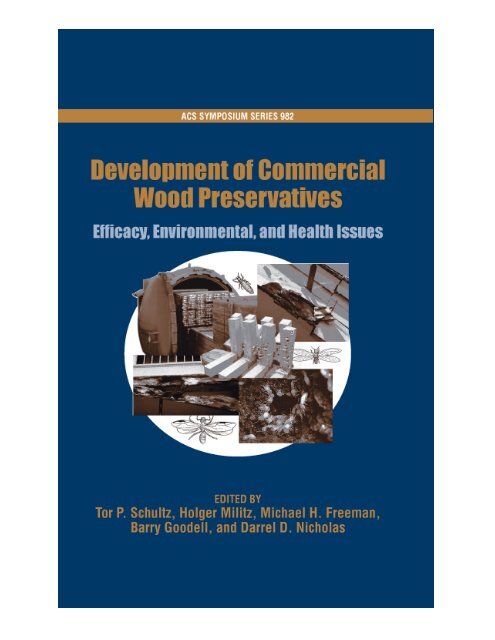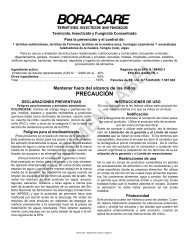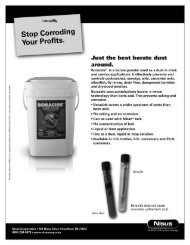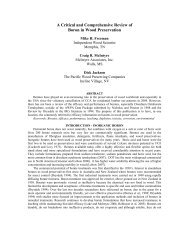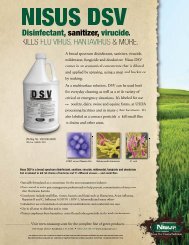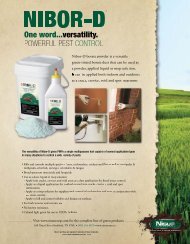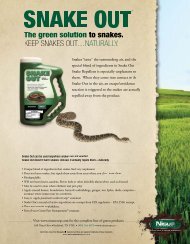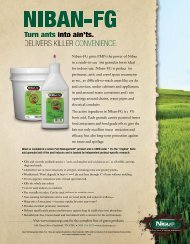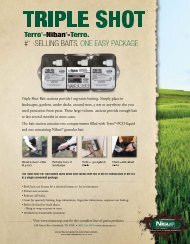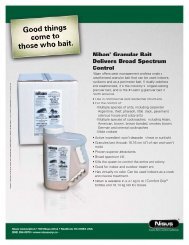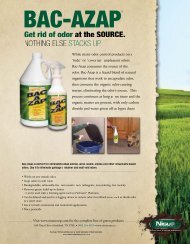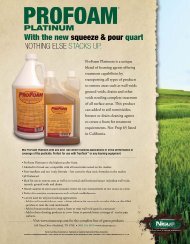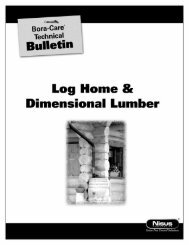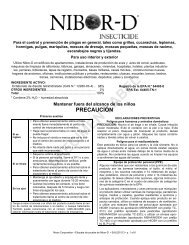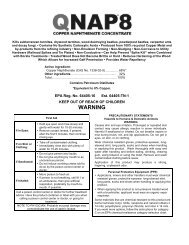Wood Preservative Formulation Development and - Wooddoc.org
Wood Preservative Formulation Development and - Wooddoc.org
Wood Preservative Formulation Development and - Wooddoc.org
You also want an ePaper? Increase the reach of your titles
YUMPU automatically turns print PDFs into web optimized ePapers that Google loves.
<strong>Wood</strong> <strong>Preservative</strong> <strong>Formulation</strong> <strong>Development</strong> <strong>and</strong> Systems:<br />
Organic <strong>and</strong> In<strong>org</strong>anic Based Systems<br />
Mike H. Freeman, Independent <strong>Wood</strong> Scientist<br />
7421 Hunters Tree Cove, Memphis, TN 38125,<br />
e-mail: wooddoc@aol.com<br />
<strong>Wood</strong> preservatives lengthen the useful service life of valuable biologically-based<br />
building materials, thereby saving the consumers money <strong>and</strong> time, <strong>and</strong> minimizing the<br />
effects of deforestation <strong>and</strong> unnecessary consumption of perishable goods. The<br />
formulation of a wood preservative can greatly impact its performance, simplify<br />
application, <strong>and</strong> affect the materials employed to apply the system <strong>and</strong> construct the<br />
final treated wood product. This chapter discusses the formulation systems used for<br />
many wood preservation applications such as pressure treatment, anti-sapstain, general<br />
/ DIY (homeowner applied) preservatives, millwork/joinery systems, <strong>and</strong> remedial<br />
treatments. Specific examples are given that have impacted the performance, efficacy,<br />
<strong>and</strong> ease of usage of both <strong>org</strong>anic <strong>and</strong> in<strong>org</strong>anic-based systems. Use of inert<br />
ingredients as formulation aids is also briefly discussed.<br />
Introduction<br />
The efficacy of any pesticide, including wood preservatives, can be greatly affected by<br />
its formulation into a commercial product. <strong>Formulation</strong>s play significant roles in how a<br />
biocide is available for both fungal <strong>and</strong> insect control as well as affecting the treated<br />
wood’s aesthetic <strong>and</strong> physical properties including preservative leaching.<br />
In general, wood preservative formulations contain actives that provide antifungal <strong>and</strong>/or<br />
insecticidal properties. In some cases blends of fungicides <strong>and</strong> insecticides or a single<br />
compound which is active against both fungi <strong>and</strong> insects may be employed, while in<br />
other cases activity against only decay fungi or insects is required.<br />
Essentially all wood preservatives employ a liquid carrier as the solvent. For lumber<br />
<strong>and</strong> timbers destined for the exterior residential market, water is the preferred solvent<br />
for the actives. Most residential preservatives currently used in North America are<br />
water borne copper-rich systems, where additional amines or ammonia are used to<br />
dissolve the copper containing preservative <strong>and</strong> minimize corrosion in the treating plant.<br />
It is expected that at some point in the future totally <strong>org</strong>anic systems that employ water<br />
insoluble agrochemicals will be required for exterior residential applications. For these<br />
systems the active will likely be formulated in water using sophisticated systems such<br />
as an emulsion or nanodispersion. Some millwork systems employ light <strong>org</strong>anic<br />
solvents, but waterborne systems are growing more predominate. For treated wood<br />
products used in the industrial sector, except for the waterborne chromated copper<br />
arsenate (CCA) system the <strong>org</strong>anic or <strong>org</strong>anometallic actives are dissolved in petroleum<br />
oil solvents, where the oils often provide some additional protection to the treated wood.<br />
The few exceptions of non-liquid carrier preservatives include the liquid creosote where<br />
the active is the carrier, a few solid preservatives such as zinc borate employed for in-
process treatment of wood composites, <strong>and</strong> solid rods for remedial treatment of inservice<br />
wood.<br />
A variety of additives are also used in wood preservative formulations. The most widely<br />
used are paraffin based water repellents that are incorporated directly into water borne<br />
treatments as emulsions or dispersions. Corrosion inhibitors, surfactants, dispersants,<br />
stabilizers, colorants, <strong>and</strong> other performance enhancers are also used but typically<br />
these types of additives are in small amounts.<br />
This chapter reviews formulation insights including current solvents <strong>and</strong> biocides, <strong>and</strong><br />
formulation additives for many wood preservative systems. Included in this overview<br />
will be current policies, practices, biocides, additives <strong>and</strong> solvents employed, the<br />
author’s personal experience in formulating many of these preservative systems <strong>and</strong> a<br />
historical review. Although all segments of the wood preservative market will be<br />
discussed, the sections are arranged in the approximate market size: pressure treating<br />
chemicals, anti-sapstain systems, millwork/joinery products, general preservative<br />
systems, <strong>and</strong> remedially treatment chemicals.<br />
Pressure Treating <strong>Preservative</strong> Systems<br />
Pressure Treating systems are the major wood preservatives, <strong>and</strong> have been employed<br />
to preserve wood since 1838 when John Bethel first patented the use of creosote for full<br />
cell treating of products such as railroad ties <strong>and</strong> timbers. Pressure treating chemical<br />
sales in the United States in 2006 alone exceeded $1 billion just for the water borne<br />
products, predominately in<strong>org</strong>anic copper carbonate <strong>and</strong> borax based biocides. Other<br />
pressure treating chemicals include <strong>org</strong>anic systems such as pentachlorophenol in oil,<br />
creosote, <strong>and</strong> creosote-petroleum systems. Interestingly, the wood preservatives used<br />
in the pressure treating arena amount to 75% of the total poundage of pesticides used<br />
in North America.<br />
The typical goal for pressure treating systems is to have an easy-to-employ system that<br />
will penetrate most wood species to protect the sapwood from decay <strong>and</strong> termites.<br />
Pressure treated wood preservatives must also be reasonably inexpensive or of good<br />
value for the money, easy to analyze in both solution <strong>and</strong> treated wood, <strong>and</strong> safe for all<br />
producers <strong>and</strong> users.<br />
The typical commodities which are pressure treated include lumber, timbers, utility<br />
poles, cross ties, piling, fence posts, fence boards, <strong>and</strong> plywood. The American <strong>Wood</strong>-<br />
Preservers’ Association (AWPA) Use Categories UC1 to UC5 list over 500 various<br />
commodities which may be commercially pressure treated. In addition to wood<br />
preservation, many fire retardant chemicals are pressure treated into wood to hinder<br />
burning, glowing or flaming/cindering.<br />
Pressure treating biocides fall into two categories. The restricted use pesticides (RUPs)<br />
are generally biocides where use at the treatment plants presents certain risks that<br />
require special knowledge for addressing so the operator must be licensed. Among the<br />
RUPs are chromated (CCA) <strong>and</strong> ammoniacal zinc copper arsenate (ACZA), other<br />
in<strong>org</strong>anic arsenicals, pentachlorophenol <strong>and</strong> creosote. The general use pesticides such<br />
as alkaline copper quat (ACQ), copper azole (CA), oxine copper, borax or DOT, <strong>and</strong> oil
or water borne copper naphthenate are not considered as risky <strong>and</strong> no special use<br />
precautions are made with these systems.<br />
Pressure treating chemicals can be further broken down into three dominate subcategories:<br />
<strong>org</strong>anic, metallic <strong>and</strong> <strong>org</strong>ano-metallic systems. Organic biocides <strong>and</strong><br />
solvents used for pressure treating for industrial applications in the USA include<br />
pentachlorophenol dissolved in AWPA P9 Type A oil or in mineral spirits <strong>and</strong> creosote<br />
either used as a st<strong>and</strong> alone AWPA P1/P13 creosote or creosote dissolved 50/50 in<br />
petroleum oils. The oils range from slurry oils to #5/#6 oils to Bunker C oils/slurry oils or<br />
HEGO oils <strong>and</strong> the resulting treatment solutiuon systems is called creosote - petroleum<br />
solutions. The metallic or <strong>org</strong>anometallic systems include CCA, ACZA, ACQ (alkaline<br />
copper quat), <strong>and</strong> CA (copper azole), which are all water borne, copper naphthenate<br />
which is both water <strong>and</strong> oil borne, the water borne in<strong>org</strong>anic borates (predominately<br />
DOT), oxine copper which is difficult to formulate but available in both oil <strong>and</strong> water<br />
borne systems, <strong>and</strong> various non-biocidal water borne fire retardant formulations that<br />
contain borates, bromine, or nitrogen- <strong>and</strong>/or phosphorus containing compounds.<br />
Solvent Differentiation in Pressure Treating<br />
Water Borne Systems<br />
Most of the pressure treated systems in the United States today are water borne<br />
systems, <strong>and</strong> essentially all treated lumber used for residential exterior applications, the<br />
largest market, are water borne. The two systems in largest use, ACQ <strong>and</strong> CA, are<br />
based on copper with a small amount of an <strong>org</strong>anic co-biocide to control copper tolerant<br />
fungi. Copper is the cheapest biocide per pound available today with the copper<br />
solubilized by employing amines, ammonia or a combination of these. (In addition there<br />
are acidic systems such as CCA <strong>and</strong> Acid Copper Chromate.) However, the added<br />
nitrogen stimulates mold growth on the treated wood which has to be further reduced by<br />
including a moldicide, typically an isothiazolinone (ITA), to the water based amine or<br />
ammonia system. The author <strong>and</strong> Pascal Kamdem of Michigan State University have<br />
recently experimented with tertiary <strong>and</strong> secondary amines <strong>and</strong> other solubilizers to<br />
minimize the use of moldicides such as isothiazolinones which are known skin<br />
sensitizers.<br />
The ammonia formulated copper systems have some advantages in that they will<br />
partially penetrate the heartwood of pines <strong>and</strong> the sapwood of refractory species such<br />
as Douglas fir. These systems are extremely effective penetrants. Ammonia<br />
formulated systems do have residual odor thus minimizing their interior use until the<br />
ammonia is thoroughly evaporated from the treated wood product, <strong>and</strong> some mold<br />
growth occurs on the treated wood since ammonia also contains high percentages of<br />
nitrogen. There is also some splotching of the treated wood, due to the d9 co-ordination<br />
complex turning from a bright blue to a light green after water/ammonia has evaporated<br />
from the system <strong>and</strong> is re-wetted either by rain water or liquid spillage onto the treated<br />
wood. Fixation is usually considered complete after the ammonia evaporates or<br />
volatizes from the treated wood. These ammonia systems are usually needed for<br />
biocide penetration in almost all Douglas fir treatments with the exception of Copper<br />
Xyligen <strong>and</strong> water borne copper naphthenate, which appear to treat Douglas fir well<br />
without ammonia.
All the major wood preservative suppliers in North America also offer water borne<br />
formulation that consists of a copper-based preservative with a wax added for water<br />
repellency. The wax is emulsified <strong>and</strong> provides enhanced dimensional stability for<br />
lumber for exterior above ground applications such as decking. This benign additive is<br />
very economical, safe, <strong>and</strong> also lessens the decay potential of wood <strong>and</strong> reduces<br />
biocide leaching.<br />
Nano-particles or micronized systems are actively being used in wood preservation<br />
today, especially for copper based systems where the copper, usually basic copper<br />
carbonate, is micronized or reduced to nano-particle size of 0.2 microns or less. These<br />
are usually coupled with a co-biocide such as an azole or quat. These micronized<br />
systems offer many advantages over the alkaline based systems which use<br />
monoethanolamine (MEA) or ammonia to solubilize/chelate the copper including<br />
reduced corrosion of treating plant equipment <strong>and</strong> metal fasteners for building the final<br />
product such as decks or fences, reduced mold growth on the treated wood <strong>and</strong> less<br />
copper leaching. For example, recent tests have shown that micronized copper leaches<br />
ten times less that amine solubilized systems <strong>and</strong> have at least one-tenth of the<br />
corrosion to mild steel fasteners <strong>and</strong> virtually no corrosion to hot dipped galvanized<br />
fasteners.<br />
Totally <strong>org</strong>anic systems that contain water insoluble <strong>org</strong>anic biocides for exterior<br />
residential applications will likely be formulated using nano particles dispersed in water<br />
or emulsion systems. Some of these systems are already available in Europe <strong>and</strong><br />
similar systems are being developed for the likely future requirement for total <strong>org</strong>anic<br />
systems for the residential North America market.<br />
Interestingly, micronized systems are not new to wood preservation. This author<br />
personally started investigating micronized systems in 1988 when the author found that<br />
oxine copper dissolved in dodecylbenzene sulphonic acid <strong>and</strong> then neutralized with<br />
borax or other borates would form a pearlescent non-settling compound. This<br />
compound, when investigated either by a Coulter Counter or a laser light scattering<br />
device, had sub-micron particle sizes <strong>and</strong> was able to penetrate wood using normal<br />
pressure treating cycles such as Rueping, Lowry, Bethell <strong>and</strong> modified full cell<br />
processes. In addition, the author found that the two component wood treating system<br />
known as CDDC or Kodiak formed a water insoluble brown complex from either copper<br />
sulfate or copper amines as the copper source <strong>and</strong> sodium dimethyl dithiocarbamate<br />
(SDDC). This water insoluble complex also had a sub-micron particle size but would<br />
settle. The author investigated passing this material through devices such as tissue<br />
homogenizers <strong>and</strong> attrition mills (attritors) to further reduce the particle size. Adding<br />
anti-caking <strong>and</strong> anti-settling compounds resulted in an effective pressure wood<br />
preservative. Chlorothalonil was also investigated since it was commonly micronized<br />
for the agricultural industry to give a particle size ranging from less than 0.1 micron to<br />
approximately 100 microns. Treating wood with formulations of chlorothalonil ground to<br />
commercial agricultural size, however, only resulted in limited penetration in southern<br />
pine due to blockages caused by the larger particles.<br />
Today roughly fifty-five percent of the industry utilizes micronized copper instead of<br />
amine based systems to produce pressure treated wood. The predominate species is<br />
southern pine but other species include Ponderosa <strong>and</strong> Radiata pines <strong>and</strong> incised Hemfir.
Oil Borne Systems<br />
Typically, <strong>org</strong>anic <strong>and</strong> <strong>org</strong>ano-metallic systems use AWPA P9 Type a Oil (#2 Fuel Oil),<br />
AWPA P9 Type C solvent (mineral spirits or VM & P Naptha), Number Six Fuel Oil or<br />
Bunker C Oil, or specialty <strong>org</strong>anic solvents. Oil or solvent borne systems are usually<br />
used for industrial products where exudates <strong>and</strong> odor are not as much a problem as in<br />
the residential market. In addition, heavy oils enhance the efficacy of the actives.<br />
Creosote is often a st<strong>and</strong> alone (no solvent carrier) wood preservative.<br />
For <strong>org</strong>anics, creosote is used mainly for railroad crossties <strong>and</strong> certain regional markets<br />
of utility poles <strong>and</strong> piling. However the dominant utility pole treatment is<br />
pentachlorophenol in oil. The author has spent over two decades doing specialty<br />
formulations of pentachlorophenol type systems for this market. These are usually<br />
based on carbonyl compounds such as ketones or ketone byproducts <strong>and</strong> water<br />
insoluble alcohols such as kettle bottoms or still bottoms from the production of 2-<br />
ethylhexanol. In addition, pentachlorophenol is readily soluble in still bottoms <strong>and</strong> kettle<br />
bottoms of cyclohexanone as well as MiBK so that 40% to 50% concentrates can be<br />
produced, shipped to the pressure treater <strong>and</strong> then further diluted with Number Two<br />
Fuel Oil, P9 Type a Oil, or equivalent.<br />
Pressure Treating Problems<br />
There are certain problems which must be addressed with all pressure treating<br />
chemicals including oil borne solutions. If not correctly formulated the solutions can<br />
entrain wood sawdust, wood sugars, <strong>and</strong> in<strong>org</strong>anic debris which can cause sludging<br />
<strong>and</strong>/or emulsion formation. Also, particles in the solution will hinder penetration, leaving<br />
the untreated sapwood prone to decay. Additionally, the solubility of the biocide in the<br />
carrier system must be maintained. If the biocide is a crystalline product such as<br />
pentachlorophenol, it can recrystallize out of solution leaving the treated wood<br />
susceptible to attack. Thus, complete solubility of any biocide in the system is essential<br />
even though most <strong>org</strong>anic biocides can not penetrate the wood cell wall. In addition,<br />
treating solutions must be relatively stable with continued re-use or penetration<br />
problems may occur with the treated wood. Problems that have occurred with water<br />
borne copper systems, including those which utilize a secondary biocide as an emulsion<br />
additive, include selective absorption, solution stability, penetration problems, <strong>and</strong><br />
sludging/particle growth problems.<br />
Anti-Sapstain Systems<br />
Anti-Sapstain systems have been around for three to five thous<strong>and</strong> years. There is<br />
historical evidence that Egyptians used powered Natrum to prevent mold growth <strong>and</strong><br />
stain <strong>org</strong>anisms from infecting sheets of papyrus. In the Shang Dynasty in China some<br />
thirty five hundred years ago workers employed wood ash dissolved in water to prevent<br />
mold <strong>and</strong> mildew growth on wood for chopsticks. The goal in any anti-sapstain <strong>and</strong> mold<br />
control system is to prevent sapstain <strong>and</strong> mold <strong>org</strong>anisms (fungi) from discovering <strong>and</strong><br />
infecting green or unseasoned wood. Anti-sapstain chemicals often called prophylactic<br />
coatings.<br />
Almost all biocides employed are dissolved or dispersed in water <strong>and</strong> applied to green<br />
lumber before air- or kiln-drying. Depending upon the application method, many<br />
different avenues of formulating an anti-sapstain chemical exist. Briefly, application
methods include use of dip tanks either as bulk or inline dip tanks, spray booths which<br />
may be sprayed either laterally or inline, flood coaters <strong>and</strong> electrostatic spray coating.<br />
In dip tank application, the volume of water is anywhere from fifty to two hundred times<br />
the level of the anti-sapstain concentrate for the anti-sapstain biocide. This allows for<br />
solutions of efficacious molecules to be applied to a relatively high surface area of green<br />
wood. In bulk dip tanks, typically the logs have been cut into board length material or<br />
flitches or veneers <strong>and</strong> are stacked on an automated lowering <strong>and</strong> raising device like a<br />
forklift mechanism <strong>and</strong> dipped for anywhere from thirty seconds to three minutes into a<br />
large volume tank which has the overflow capacity to hold both the lumber <strong>and</strong> the<br />
treating solution. Inline dip tanks take the wood that is coming linearly or laterally from<br />
the sawmill <strong>and</strong>, before further machining, quickly dip the material into an aqueous<br />
solution of the biocide dispersed or solubilized in water.<br />
Spray booths, either lateral or inline, are exactly as defined by the term. In these<br />
applications dispersions or true solutions of biocides in water are sprayed as an ultrafine<br />
mist onto all six surfaces of the board before it is dried. Flood coaters, typically<br />
called rain shower booths, have been used for years but are now falling out of favor due<br />
to environmental exposure to workers. Flood coaters basically applied the diluted antisapstain<br />
chemical in a ribbon-like feed where the wood was passed under the flood<br />
coater <strong>and</strong> coated on all four large surface sides with some ingrain coating as well.<br />
Electrostatic coverage usually involves first coating the wood with an ionic compound or<br />
solution so that the wood surface could carry a charge, or if the wood has sufficient<br />
moisture content charging the surface of the wood <strong>and</strong> then putting a counter ionic<br />
charge on the spray solution to allow coverage of the wood surface regardless of the<br />
application angle from any spray head.<br />
Today’s anti-sapstain preservative systems are predominately water soluble or water<br />
dispersible concentrates. The pH of today’s systems can range from neutral to acidic or<br />
alkaline. Alkaline systems have typically been employed in the past to minimize iron<br />
stain due to iron contacting the green wood <strong>and</strong> later forming iron tannate complexes,<br />
as well as minimizing corrosion in the mild steel used to manufacture anti-sapstain<br />
application equipment.<br />
Solvents<br />
Water is the dominant solvent in use today due to economic <strong>and</strong> safety reasons <strong>and</strong><br />
ease of application. In addition to water, there can be water dispersible co-solvents,<br />
cationic or anionic emulsifiers, alcohols, glycols, esters, <strong>and</strong> dispersing agents.<br />
Biocides<br />
Historically mercuric compounds, toxic to both man <strong>and</strong> fungi, launched the “modern”<br />
anti-sapstain work some 200 years ago. These mercury formulations included water<br />
soluble salts, usually phenol mercuric acetate or phenol mercuric lactate, with a<br />
lignosulphonate emulsifier <strong>and</strong> a co-solvent.<br />
In the 1930s the chlorophenate compounds developed for wood preservation gained<br />
prominence for mold <strong>and</strong> stain control. Furthermore, synergism was found when<br />
chlorophenates were combined with borates. These systems also minimized iron stain<br />
on the wood, prevented corrosion in mild steel dip tanks <strong>and</strong> resulted in greater efficacy<br />
against decay <strong>org</strong>anisms. Additionally, the small amount of free chlorine in the
chlorophenate systems acted as a wood surface bleaching agent making the wood<br />
surface “brighter” to enhance the appeal of the treated wood. The only problem was<br />
that some Cepheloascus fungi were tolerant, but it was found that adding a trace of a<br />
mercuric compound to the chlorophenate formulation controlled the complete spectrum<br />
of mold <strong>and</strong> stain <strong>org</strong>anisms.<br />
Chlorophenates, however, began to be reviewed in the 1980s due to the negative<br />
publicity concerning compounds such as agent orange <strong>and</strong> other phenoxy herbicides.<br />
New biocides for the anti-sapstain began to replace the chlorophenates which had been<br />
used for over half a century.<br />
The first launch into non-chlorophenate anti-sapstain control was based on oxine<br />
copper (copper-8-quinolinolate, or copper-8 or Cu-8). Patents were granted worldwide<br />
for the use of oxine copper dissolved in dodecylbenzene sulphonic acid (DDBSA).<br />
Work by West <strong>and</strong> Nagel <strong>and</strong> others found that oxine copper dissolved in DDBSA was a<br />
very robust <strong>and</strong> effective system for anti-sapstain control. <strong>Formulation</strong>s based on this<br />
technology still exist today.<br />
Further work on non-metallic systems included the investigation of quaternary<br />
ammonium compounds (quats) <strong>and</strong> carbamates. Included in these is a formulation<br />
known as NP-1 that is a mixture of IPBC <strong>and</strong> DDAC (3-iodo-2-propynyl butyl carbamate<br />
<strong>and</strong> didodecyldimethylammonium chloride). Additional investigation into phenolic based<br />
compounds included uses of OPP (ortho-phenoxy phenol) <strong>and</strong> Sodium OPP, commonly<br />
referred to Dowicide 1 <strong>and</strong> Dowicide A. These phenolic formulations have certain side<br />
effects which limit their use even though they are effective biocides.<br />
Additional work into the investigation of mold <strong>and</strong> mildew control for lumber, based on<br />
testing of fungicides for the leather <strong>and</strong> pulp <strong>and</strong> paper industries by Stanley Buckman,<br />
included formulations based on TCMTB <strong>and</strong> MBT (2-(thiocyanomethylthio)<br />
benzothiazole <strong>and</strong> methylene bis-thiocyanate). These formulations, although extremely<br />
robust, had certain negative implications concerning worker exposure such as dermal<br />
<strong>and</strong> eye irritation.<br />
Studies in America, New Zeal<strong>and</strong> <strong>and</strong> Australia also found that certain co-biocide<br />
combinations, including those of oxine copper <strong>and</strong> carbendizim, or oxine copper <strong>and</strong><br />
chrolothalonil (CTL), proved to be synergistic <strong>and</strong> very effective anti-sapstain <strong>and</strong> mold<br />
control combinations. These products are currently marketed under the trade names<br />
Nexgen <strong>and</strong> Hylite Extra, respectively. Additionally, a formulation innovation by West,<br />
Freeman <strong>and</strong> Accampo dissolved certain biocides in high concentrations in amine<br />
phosphonate systems. These amine phosphate systems, currently called The StaBrite<br />
System, could dissolve biocides such as IPBC, <strong>and</strong> the azoles azaconazole,<br />
propiconazole, <strong>and</strong> tebuconazole. The largest commercial system is the StaBrite P<br />
System, a formulation of IPBC in the patented amine phosphonate carrier. It was later<br />
discovered that the amine phosphonate carrier system was also an excellent bleaching<br />
compound for the surface of the wood to give a brighter appearance <strong>and</strong> greater appeal<br />
as well as inhibited corrosion with the mild steel dip tanks <strong>and</strong> removed saw marks <strong>and</strong><br />
iron tannate stains from the wood surface. Additional patents were given for the amine<br />
phosphonate system as a hard surface cleaning agent, very similar to the patents<br />
issued for quaternary ammonium compounds for the same application.<br />
The leading biocide formulations in today’s anti-sapstain market include NexGen (MBT<br />
<strong>and</strong> CTL), NP-1 (IPBC <strong>and</strong> DDAC), Busan 1009 (TCMTB (2-(thiocyanomethylthio)
enzothiazole, also called Busan 30) <strong>and</strong> MBT (methylene bis-thiocyanate)), MicoStat P<br />
(propiconazole <strong>and</strong> DDAC), Brite<strong>Wood</strong> XL, Brite<strong>Wood</strong> S, Brite<strong>Wood</strong> P, <strong>and</strong> a new entry<br />
called Bazooka. In addition, new environmentally formulations launched in the last 24<br />
months include formulations of sterol inhibitor-based chemicals that usually employ<br />
propiconazole or propiconazole/tebuconazole/IPBC combinations such as Premier <strong>and</strong><br />
Anti Blu XP. Additionally in North America, particularly Canada, formulations of sodium<br />
carbonate mixed with borax <strong>and</strong> marketed under the name F2 have market niches<br />
where environmental concern for water run off from the treated wood <strong>and</strong> worker<br />
exposure give it a semi-permanent market position.<br />
To recap, the biocides used in anti-sapstains are:<br />
• Oxine Copper<br />
• IPBC<br />
• DDAC<br />
• Isothiazilines<br />
• TCMTB/Busan 30<br />
• MBT<br />
• CTL<br />
• Propiconazole<br />
• Tebuconazole<br />
• OPP<br />
• NaOPP<br />
• Borax<br />
• Sodium Carbonate<br />
<strong>Formulation</strong> Additives<br />
<strong>Formulation</strong> additives are typically used to add a particular trait or physical property to<br />
the biocide system to mitigate effects of the primary biocide system on operating<br />
equipment, enhance the efficacy of the actives, or improve the wood properties such as<br />
brightness <strong>and</strong> color. Borax, the historical anti-sapstain additive, is typically used to<br />
make the system alkaline to prevent iron stain from occurring on the wood, darkening of<br />
the heartwood, particularly in Douglas fir, <strong>and</strong> minimize corrosion to the mild steel<br />
equipment used in the treating process.<br />
Substituted phosphonic acids began to gain wide appeal in the early 1990s when it was<br />
found that these products were inexpensive <strong>and</strong> would chelate iron <strong>and</strong> iron compounds<br />
into colorless or white coordination complexes which would not stain or discolor the<br />
wood. These substituted phosphonic acids chelated the iron from the solution <strong>and</strong>,<br />
when the phosphate content was high enough, would actually act to brighten the<br />
surface.<br />
Emulsifiers <strong>and</strong> dispersants keep active ingredients concentration uniform <strong>and</strong><br />
dispersed in both the concentrate <strong>and</strong> the ready-to-use (RTU) solutions. These<br />
emulsifiers <strong>and</strong> dispersants, historically based on both anionic <strong>and</strong> cationic compounds<br />
which lead to selective absorption of the biocide on the wood, are now sometime<br />
coupled with other chemical formulation additives which include distinct surface active<br />
ingredients to prevent hard cake settling in dip tanks <strong>and</strong> ensuring uniform distribution of<br />
the biocide on the wood surface.
Although not considered an anti-sapstain <strong>org</strong>anism, insect attack, especially to<br />
hardwoods, is of growing concern. It is known that insect movement can lead to the<br />
spread of sap <strong>and</strong> mold fungi from lumber piece to lumber piece or stack to stack.<br />
Therefore insecticides have been added to anti-sapstain formulations to prevent attack<br />
<strong>and</strong> infestation by Lyctid, Anoobiid. <strong>and</strong> Ambrosia Beetles <strong>and</strong> termites for over 70<br />
years. Historically, the largest insecticide used for this purpose was Lindane (gamma<br />
hexachlorobenzene). Today’s market includes other insecticides such as Chloropyrifos,<br />
Imidicloprid, <strong>and</strong> Permethrin.<br />
Water repellents have been added to Anti-Sapstain chemical formulation to minimize<br />
checking <strong>and</strong> splitting while the wood was drying or seasoning, which further made the<br />
anti-sapstain chemicals more effective by not opening up untreated wood to new<br />
exposure sites.<br />
New systems now generally contain a diffusible biocide plus a biocide that stays on the<br />
wood surface. These new systems are compatible with currently available insecticides,<br />
are stable in solution <strong>and</strong> the biocide concentration is easy to analyze both on the wood<br />
<strong>and</strong> in solution. In addition, new biocides can be easily detected on the wood surface<br />
by employing a presence indicator that can be sprayed or applied to the wood surface.<br />
The products in today’s market provide cost effective, efficient, <strong>and</strong> safe yet effective<br />
<strong>and</strong> efficacious protection against stain <strong>and</strong> mold <strong>org</strong>anism’s infestation to green wood<br />
prior to seasoning. Although formulation improvements continue in the anti-sapstain<br />
market, the biocides will likely continue to be agricultural fungicides which have broad<br />
spectrum effectiveness <strong>and</strong> an extensive environmental data package.<br />
Millwork <strong>and</strong> Joinery Systems<br />
The principal goal in millwork <strong>and</strong> joinery systems is to deliver an active fungicide, or<br />
active fungicide <strong>and</strong> insecticide combination along with a water repellent to give surface<br />
mold, decay <strong>and</strong> insect protection <strong>and</strong> provide excellent water repellency <strong>and</strong><br />
dimensional stability to the product. The secondary goal of a millwork or joinery system<br />
is surface preparation for future coating, staining, or cladding.<br />
Historically, millwork systems used 5% pentachlorophenol (also called penta) in mineral<br />
spirits with additional wax, or mercurial compounds which were oil or mineral spirits<br />
soluble, with these systems employed for 70 years. However, concern arose for use of<br />
pentachlorophenol in this application during the US EPA RPAR Hearings of the late<br />
1970s <strong>and</strong> the early 1980s, <strong>and</strong> mercury derivatives were also restricted. Additional<br />
work led to tributyltin oxide (TBTO) <strong>and</strong> tributyltin naphthenate some three decades<br />
ago, <strong>and</strong> although use of these compounds has greatly reduced they still maintain some<br />
market share. Following the conversion of pentachlorophenol from a general use to a<br />
restricted use pesticide in the late 1980s, millwork <strong>and</strong> joinery manufacturers decided<br />
that they would prefer to employ a general use pesticide rather then to obtain Certified<br />
Applicator licenses through Certified Applicator Training. This forced the chemical<br />
formulators to look at non-chlorophenate systems.<br />
Biocides<br />
Millwork biocides currently employed include:<br />
• IPBC<br />
• Oxine Copper
• Propiconazole<br />
• Tebuconazole<br />
• TBTO<br />
• TCMTB<br />
• Chlorpyrifos<br />
• Permethrin<br />
• Imidicloprid<br />
• Bifenthrin<br />
Since many of today’s fungicides are non-insecticidal, an insecticide must be added to<br />
millwork systems to prevent insect attack. These include Lindane, Bifenthrin,<br />
Chloropyrifos, Permethrin, Pyrethrums, <strong>and</strong> Imidicloprid. Historically, Dieldrin, Aldrin,<br />
Chlordane, <strong>and</strong> Esfenvalerate have also been used. Recent studies on the insecticide<br />
compound Bifenthrin continue to show promise as this molecule is active at dosage<br />
rates 100-1000 times less than other insecticides in the same generic class.<br />
The fungicide <strong>and</strong> insecticide combinations currently used are soluble or easily<br />
dispersible in mineral based systems, or can easily be converted to a water dispersible<br />
or water emulsifiable system through the use of co-solvents <strong>and</strong> emulsifiers. Of the 64<br />
plants in North America currently treating with millwork preservative systems, IPBC is<br />
the major biocide employed for millwork. Sold under a wide variety names such as<br />
<strong>Wood</strong> Life, Mitrol IPBC, <strong>and</strong> DAP Ready-to-Use, IPBC has replaced 90% of the market<br />
that was formally pentachlorophenol <strong>and</strong> new formulations of IPBC <strong>and</strong> co-biocides<br />
continue to emerge. For example, a new formulation containing IPBC coupled with<br />
propiconazole <strong>and</strong> tebuconazole in a mineral based system that contains paraffin wax is<br />
marketed under the name <strong>Wood</strong> Life 111. <strong>Wood</strong> Life 111 takes advantage of the<br />
synergism between propiconazole <strong>and</strong> tebuconazole by adding them to the broad<br />
spectrum of decay protection of IPBC. Although IPBC will break down into iodine-based<br />
compounds under high heat or alkaline conditions, such as those typically those found<br />
in cladding operations, studies have found that the azole compounds in these multibiocide<br />
systems remain effective.<br />
Solvents<br />
The major solvent currently used for millwork <strong>and</strong> joinery systems continues to be<br />
mineral spirits. Although over half a dozen different versions of mineral spirits are<br />
available, by far the largest is Rule 66, a low odor mineral spirits where the aromatic<br />
content is 2% or less. For millwork manufactures who want to quickly evaporate the<br />
solvent from the system, the mineral spirits can be readily replaced by VM & P Naphtha<br />
(Lacolene). Some millwork preservative systems employ water as the carrier <strong>and</strong><br />
include wax for dimensional stability <strong>and</strong> block co-polymers to further give the wood<br />
dimensional stability <strong>and</strong> minimal grain raising during the application <strong>and</strong> re-drying<br />
process.<br />
Some additives are included in the millwork <strong>and</strong> joinery systems. The most common is<br />
approximately 0.75% w/w of a ready-to-use solution of paraffin wax. And although<br />
many paraffin waxes are used, most common are those with an approximately 104 –<br />
115 ºF melt point <strong>and</strong> a medium to moderate needle penetration value. Some paraffin<br />
waxes have been replaced by small quantities of microcrystalline wax or hydrophobic<br />
polymers. Other additives to interior systems include trace levels of aromatic solvents<br />
in which an effective insecticide has been added.
Additional Factors<br />
Additional formulation developments generally involve enhancing dimensional stability<br />
<strong>and</strong> water repellency. Although water repellency may be initially thought to be quickly<br />
<strong>and</strong> easily determined by simple test methods such as contact angle of water droplets<br />
on the wood surface, other investigations found that long term swellometer tests are<br />
more informative for determining the long term dimensional stability of the treated wood<br />
product. Automated swellometers coupled with computer systems have also shown<br />
that if dimensional stability is maintained for 100 hours, typically the product will perform<br />
well in service.<br />
Additional tests on millwork formulated systems include simple paintability tests such as<br />
the Hatch Mark Test <strong>and</strong> analytical procedures for active ingredient determination for<br />
both penetration <strong>and</strong> retention, typically in the endgrain of the treated commodity.<br />
New innovations in the millwork <strong>and</strong> joinery systems include pressure treating the<br />
commodities with water based system that includes a water repellent, allowing the wood<br />
to dry <strong>and</strong> then machining the wood product to its final dimensions. Innovative work in<br />
this area has recently been incorporated by the Jeld-Wen Corporation using their Aura<br />
Last <strong>Preservative</strong> System. However, there have been some complaints of increased<br />
corrosion to metal fasteners <strong>and</strong> other metal parts used in window manufacturing.<br />
Additionally, new water based preservative compounds such as Wolman AG (or<br />
Wolman L-3), a mixture of tebuconazole, propiconazole, <strong>and</strong> imidacloprid, for above<br />
ground uses of pressure treated wood, may allow treated wood to be used in millwork<br />
<strong>and</strong> joinery applications if dried after treatment <strong>and</strong> machined into place, similar to the<br />
Aura Last System. Although millwork <strong>and</strong> joinery preservatives, often called the LOSP<br />
(Light Organic Solvent <strong>Preservative</strong>) systems in Australasia <strong>and</strong> Europe, have been<br />
around for over 100 years, research continues to improve these systems to provide<br />
longer lasting products for the homeowner in the future.<br />
General <strong>Preservative</strong> Systems<br />
General <strong>Preservative</strong> Systems are those wood preservatives, biocides, <strong>and</strong> insecticide<br />
formulations which are best described by their name. These products are used as ‘doit-yourself’<br />
products by home owners <strong>and</strong> small industry users. These products employ<br />
general use pesticides to ensure their availability to over-the-counter purchasers <strong>and</strong><br />
applicators without a certified pesticide license. Typical applications include brush-on,<br />
soak, dip, <strong>and</strong> spray on systems. The goal of general wood preservative systems is to<br />
provide protection against mold, mildew, decay fungi <strong>org</strong>anisms <strong>and</strong> possibly insect<br />
protection when pressure treated wood is not available or not desirable. The secondary<br />
goal is that the products be easy to apply, relatively safe to workers <strong>and</strong> homeowners,<br />
easy to clean up, <strong>and</strong> employ general use pesticides. The ability for the treated wood<br />
to be painted, i.e. have paintability <strong>and</strong> stainability, are also desirable properties.<br />
Biocides<br />
With the exception of in<strong>org</strong>anic borates such as DOT (disodium octaborate<br />
tetrahydrate), most of the general wood preservatives are <strong>org</strong>ano-metallic complexes or<br />
<strong>org</strong>anic chemicals. These include copper naphthenate, both oil <strong>and</strong> water borne, IPBC,
chlorothalonil, oxine copper, Folpet, zinc naphthenate, <strong>and</strong> quaternary ammonium<br />
compounds (quats) such as DDAC.<br />
Solvents<br />
The most common solvent for general preservatives are mineral spirits, which is usually<br />
of the variety of Rule 66 Low Odor Mineral Spirits which has a low aromatic content to<br />
minimize worker exposure as well as odor of the treated wood product. In addition,<br />
mineral spirits plus paraffin or microcrystalline wax is often used when water repellency<br />
is desired. Other solvents include AWPA Type P9A Oil (#2 Fuel Oil or equiv.) <strong>and</strong><br />
recently biodiesel (methyl soyate). When a drying oil is desired typically tung oil,<br />
linseed oil, or their combination is employed. Water plus either surfactants or<br />
emulsifiers are also used, sometimes with polymers or waxes to impart water repellency<br />
to the treated wood.<br />
General preservative systems typically have a few formulation specifics which they must<br />
meet along with being efficacious. These include easy clean-up, relatively safe for any<br />
exposure, <strong>and</strong> non-phototoxic so terrestrial <strong>and</strong> non-terrestrial plants are not affected if<br />
a spill occurs. These systems should also be compatible with almost all container types<br />
<strong>and</strong> should be tested accordingly to make sure they are compatible with typical<br />
containers which a home owner would use to store these products. In addition, the<br />
product should be shelf stable <strong>and</strong> have a uniform distribution both in the concentrate<br />
<strong>and</strong> in the ready-to-use solution during storage <strong>and</strong> immediately before application.<br />
Remedial Treatment Systems<br />
Remedial Treatment Systems are used to arrest decay <strong>and</strong> insect attack in both<br />
untreated wood <strong>and</strong> in wood where the original preservative has been depleted to below<br />
threshold value permitting attack by insects <strong>and</strong> decay <strong>org</strong>anisms. Thus, the goal of<br />
remedial treatment systems is to extend the useful service life of a treated or previously<br />
untreated wood member, with the secondary goal to stop or eliminate any current attack<br />
by fungi or insects.<br />
Remedial treatment chemicals used previously include many historical biocides such as<br />
pentachlorophenol, creosote, sodium dichromate, arsenic acid, borax or boric acid,<br />
sodium fluoride, copper naphthenate, lindane, <strong>and</strong> chloropyrifos as well as<br />
fillers/carriers like clays <strong>and</strong> thixotropic (water thicking) agents. Biocides currently used<br />
include copper naphthenate, copper hydroxide, boric acid, borax, sodium fluoride, <strong>and</strong><br />
DOT. Remedial treatment systems generally fall into four predominately large<br />
categories; Thixotropic Gels or Pastes which may be either oil or water borne,<br />
Fumigants, Solid Rods, or Liquid Injectable Systems.<br />
By far the largest category is the Thixotropic Gels or Pastes. The most effective<br />
remedial gels/pastes contain one agent that closely adheres to the wood surface, such<br />
as the base of the utility pole where a groundline decay can occur most readily, <strong>and</strong> a<br />
second agent which diffuses deeply into the wood, possibly even into the previously<br />
untreated heartwood. Products sold in this market over the years include many of the<br />
products under the Pole Nu or the Osmoplastic name usually followed by a number or<br />
letter such as Pol Nu CuRAP 20 or Osmoplastic B, Osmoplastic F, or Osmoplastic CF.<br />
Fumigants in this area include products such as vapam (Metam Sodium) usually<br />
employed as a 32.7% water borne active ingredient concentrate, chloropicrin, sulfuryl
fluoride or MITC (methyl isothiocyanate). In addition, solid rods such as IMPEL rods,<br />
FluroRods, or Cobra rods are also used as both a preventative <strong>and</strong> also as a curative in<br />
the remedial treatment arena. Rods have had some complaints against them in that<br />
they sit as a reservoir of wood preservatives until the treated wood has a high enough<br />
moisture content to dissolve the rod but that means the high moisture content can also<br />
promote <strong>and</strong> sustain decay.<br />
In addition to solid rods there are also solid fumigants which are a sub-category of both<br />
the Fumigant Category as well as the Solid Chemicals Category. These include such<br />
new fumigants as Basimid (Dazomet) which produces methylisothiocyanate upon<br />
reaction with wood acids, as does Vapam <strong>and</strong> Mitc-Fume. Some researchers have<br />
found that the addition of an acidic copper compound, like copper sulfate, dissolved in<br />
water <strong>and</strong> co-introduced into the same application site as Basimid increases its toxicity<br />
<strong>and</strong> stoichiometric yield.<br />
Liquid Injectable Systems are used to treat wood voids. Historically the biggest product<br />
used in this market for this application has been a product produced by Osmose called<br />
Hollow Heart. However, Hollow Heart contained significant amounts of toxic chemicals<br />
<strong>and</strong> has been replaced by a new environmentally friendly formulation called Hollow<br />
Heart CF which is a mixture of Copper Naphthenate <strong>and</strong> Sodium Fluoride. These liquid<br />
injectable systems are usually placed into wood voids after drilling the wood to<br />
determine if a void exists in the interior <strong>and</strong> injected under low pressure to fill the void to<br />
arrest decay <strong>and</strong> insect attack.<br />
Summary <strong>and</strong> Conclusions<br />
<strong>Wood</strong> preservative use has grown in the last 170 years into a modern, well segmented,<br />
complex <strong>and</strong> sophisticated market which extends the usable service life of wood thus<br />
saving the homeowners or other consumers’ money <strong>and</strong> time while reducing harvesting<br />
<strong>and</strong> deforestation in the world. One should remember that chemical treatment costs<br />
pennies but saves dollars if the product is formulated correctly, <strong>and</strong> that toxic biocides<br />
can be safely h<strong>and</strong>led if adequately formulated.<br />
Specific goals for new wood preservative systems include good efficacy against the<br />
wide variety of oranisms that can degreade the wood product in its intended application,<br />
ease of formulating, ease of analysis in both the solution <strong>and</strong> the treated wood, good<br />
penetration into the wood, <strong>and</strong> safe for the environment, human applicators <strong>and</strong> final<br />
users. They must also have a good cost-to-benefit ratio <strong>and</strong> be economical in the long<br />
run for the producer. New wood preservative formulations now being examined are<br />
mostly based on agriculture <strong>org</strong>anic biocides for employment in the large residential<br />
lumber market. These biocides are not water soluble so will have to be formulated<br />
using new formulation technologies such as nano-particle dispersion <strong>and</strong> emulsion<br />
systems. Emulsion systems recently developed do not have the faults of older<br />
emulsions such as water dispersible pentachlorophenol.<br />
These new nano-dispersion <strong>and</strong> emulsion systems are already in the marketplace or<br />
going through the AWPA <strong>and</strong>/or the Building Codes (ICC-ES) for listing. Finally, new<br />
systems are essentially “cocktails” because many of the new agricultural chemicals<br />
being considered have a limited spectrum of activity, so biocide mixtures are used to<br />
obtain the broad fungicide <strong>and</strong> insecticide protection necessary for the long service life<br />
of treated wood. This means that formulation complexity may be increased.
<strong>Formulation</strong> is extremely complex <strong>and</strong> this chapter only provides an introduction. It is<br />
recommended that any proposed formulation change involve input by both a formulation<br />
chemist <strong>and</strong> wood preservationist, along with other professionals, to ensure that any of<br />
the many possible negative impacts will be properly addressed.<br />
Suggested Further Reading<br />
Anonymous. STP 752.Vertebrate Pest Control <strong>and</strong> Management Materials. ASTM<br />
International, ASTM Press, West Coshocton, PA, 1981<br />
Anonymous. .STP 764.Pesticide Tank Mix Applications<br />
Editor(s): Wright; Lindsay; Sawyer. ASTM International, ASTM Press, West Coshocton,<br />
PA, 1982.<br />
Anonymous. STP 795. Pesticide <strong>Formulation</strong>s <strong>and</strong> Application Systems. Editor(s): K G<br />
Seymour. ASTM International, ASTM Press, West Coshocton, PA, 1983.<br />
Anonymous. STP 828. Pesticide <strong>Formulation</strong>s <strong>and</strong> Application Systems: 3rd<br />
Symposium. Editor(s): Kaneko; Akesson, ASTM International, ASTM Press, West<br />
Coshocton, PA, 1984<br />
Anonymous. STP 875. Pesticide <strong>Formulation</strong>s <strong>and</strong> Application Systems. Editor(s):<br />
Kaneko; Spicer, ASTM International, ASTM Press, West Coshocton, PA, 1981<br />
Anonymous. STP 915. Pesticide <strong>Formulation</strong>s <strong>and</strong> Application Systems: Fifth<br />
Symposium.Editor(s): Spicer; Kaneko, ASTM International,ASTM Press, West<br />
Coshocton, PA, 1986.<br />
Anonymous. STP 943. Pesticide <strong>Formulation</strong>s <strong>and</strong> Application Systems: Sixth Volume.<br />
Editor(s): V<strong>and</strong>er Hooven; Spicer, ASTM International,ASTM Press, West Coshocton,<br />
PA, 1987.<br />
Anonymous. STP 968. Pesticide <strong>Formulation</strong>s <strong>and</strong> Application Systems. Editor(s):<br />
Beestman; V<strong>and</strong>er Hooven, ASTM International, ASTM Press, West Coshocton, PA,<br />
1987.<br />
Anonymous. STP 980. Pesticide <strong>Formulation</strong>s <strong>and</strong> Application Systems. Editor(s):<br />
Hovde; Beestman, ASTM International, ASTM Press, West Coshocton, PA, 1989.<br />
Anonymous. STP 1036. Pesticide <strong>Formulation</strong>s <strong>and</strong> Application Systems: International<br />
Aspects.Editor(s): Hazen; Hovde, ASTM International,ASTM Press, West Coshocton,<br />
PA, 1989.<br />
Anonymous. STP 1078. Pesticide <strong>Formulation</strong>s <strong>and</strong> Application Systems. Editor(s):<br />
Bode; Hazan; Chasin, ASTM International, ASTM Press, West Coshocton, PA, 1990.<br />
Anonymous. STP 1112. Pesticide <strong>Formulation</strong>s <strong>and</strong> Application Systems: 11th Volume.<br />
Editor(s): Bode; Chasin, ASTM International, ASTM Press, West Coshocton, PA, 1992.<br />
Anonymous. STP 1146.Pesticide <strong>Formulation</strong> <strong>and</strong> Application Systems. Editor(s):<br />
Devisetty; Chasin; Berger, ASTM International, ASTM Press, West Coshocton, PA,<br />
1993
Anonymous. STP 1183. Pesticide <strong>Formulation</strong>s <strong>and</strong> Application Systems, 13th<br />
Volume.Editor(s): Berger, Devisetty, Hall, ASTM International, ASTM Press, West<br />
Coshocton, PA, 1993<br />
Anonymous. STP 1234. Pesticide <strong>Formulation</strong>s <strong>and</strong> Application Systems: 14th Vol.<br />
Editor(s): Hall, Berger, Collins, ASTM International, ASTM Press, West Coshocton, PA,<br />
1995<br />
Anonymous. STP 1268. Pesticide <strong>Formulation</strong>s <strong>and</strong> Application Systems: 15th Volume.<br />
Editor(s): H.M. Collins, F.R. Hall, M. Hopkinson, ASTM International, ASTM Press, West<br />
Coshocton, PA, 1996<br />
Anonymous. STP 1312. Pesticide <strong>Formulation</strong>s <strong>and</strong> Application Systems: 16th Volume.<br />
Editor(s): Hopkinson, Collins, Goss, ASTM International, ASTM Press, West<br />
Coshocton, PA, 1997<br />
Anonymous. STP 1328.Pesticide <strong>Formulation</strong>s & Application Systems: 17th<br />
Volume.Editor(s): G.R. Goss, M J. Hopkinson, H.M. Collins, ASTM International, ASTM<br />
Press, West Coshocton, PA, 1997<br />
Anonymous. STP 1347. Pesticide <strong>Formulation</strong>s <strong>and</strong> Application Systems: 18th Volume.<br />
Editor(s): Nalewaja, Goss, Tann, ASTM International, ASTM Press, West Coshocton,<br />
PA, 1998<br />
Anonymous. STP 1373. Pesticide <strong>Formulation</strong>s <strong>and</strong> Application Systems: Global Pest<br />
Control <strong>Formulation</strong>s for the Next Millennium, 19th Volume. Editor(s): R. Scott Tann;<br />
John D. Nalewaja; Alan K. Viets, ASTM International, ASTM Press, West Coshocton,<br />
PA, 1999<br />
Anonymous. STP 1400. Pesticide Fomulations <strong>and</strong> Application Systems, 20th Volume.<br />
Editor(s): Alan K. Viets; R. Scott Tann; Jane C. Mueninghoff, ASTM International,<br />
ASTM Press, West Coshocton, PA, 2001<br />
Anonymous. STP 1414. Pesticide <strong>Formulation</strong>s <strong>and</strong> Application Systems: A New<br />
Century for Agricultural <strong>Formulation</strong>s, 21st Volume. Editor(s): Jane C. Mueninghoff;<br />
Alan K. Viets; Roger A. Downer, ASTM International, ASTM Press, West Coshocton,<br />
PA, 2001<br />
Anonymous. STP 1430. Pesticide <strong>Formulation</strong>s <strong>and</strong> Delivery Systems: Meeting the<br />
Challenges of the Current Crop Protection Industry. Editor(s): Roger A. Downer; Jane<br />
C. Mueninghoff; Gregory C. Volgas, ASTM International, ASTM Press, West<br />
Coshocton, PA, 2003<br />
Anonymous. STP 1449. Pesticide <strong>Formulation</strong>s <strong>and</strong> Application Systems: 23rd Volume.<br />
Editor(s): Greg Volgas, Roger A. Downer, Humberto B. Lopez, ASTM International,<br />
ASTM Press, West Coshocton, PA, 2003<br />
Anonymous. STP 1460. Pesticide <strong>Formulation</strong>s <strong>and</strong> Delivery Systems: The Continued<br />
Evolution of Agrochemicals, 24th Volume. Editor(s): G. Robert Goss; Gregory C.<br />
Volgas; Masoud Salyani, ASTM International, ASTM Press, West Coshocton, PA, 2005
Anonymous. Velsicol Pesticide Formulators H<strong>and</strong>book. Velsicol Chemical Corp.,<br />
Memphis, TN. 196 pp., 1974.<br />
Anonymous. WITCO Pesticide <strong>and</strong> Emulsifier H<strong>and</strong>book. WITCO Chemicals. 146 pp.,<br />
1977.<br />
UNIDO. Pesticide <strong>Formulation</strong>. United Nations Industrial Dev. Organization. 484.pp.,<br />
1998.


